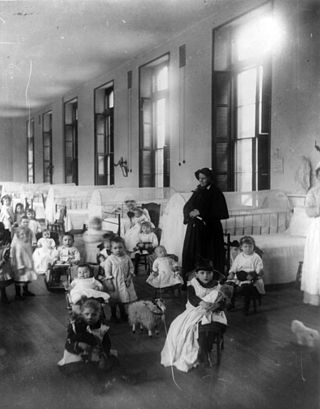Related Research Articles

Adoption is a process whereby a person assumes the parenting of another, usually a child, from that person's biological or legal parent or parents. Legal adoptions permanently transfer all rights and responsibilities, along with filiation, from the biological parents to the adoptive parents.
International adoption is a type of adoption in which an individual or couple residing in one country becomes the legal and permanent parent(s) of a child who is a national of another country. In general, prospective adoptive parents must meet the legal adoption requirements of their country of residence and those of the country whose nationality the child holds.
Closed adoption is a process by which an infant is adopted by another family, and the record of the biological parent(s) is kept sealed. Often, the biological father is not recorded—even on the original birth certificate. An adoption of an older child who already knows their biological parent(s) cannot be made closed or secret. This used to be the most traditional and popular type of adoption, peaking in the decades of the post-World War II Baby Scoop Era. It still exists today, but it exists alongside the practice of open adoption. The sealed records effectively prevent the adoptee and the biological parents from finding, or even knowing anything about each other. However, the emergence of non-profit organizations and private companies to assist individuals with their sealed records has been effective in helping people who want to connect with biological relatives to do so.
Embryo donation is one disposition option for users of in vitro fertilisation with remaining fresh or frozen embryos. It is defined as the giving—generally without compensation—of embryos remaining after in vitro fertilization procedures to recipients for procreative implantation or research. Most IVF users with supernumerary embryos make embryo donation decisions after completing their families or discontinuing use of in vitro fertilization. Recipients of embryos donated for procreative implantation typically plan to transfer fresh or frozen embryos into a prepared uterus in order to facilitate pregnancy and childbirth. Recipients of embryos donated for research typically use them for clinical training, quality improvement research, or human embryonic stem cell research.

More adoptions occur in California each year than any other state. There is domestic adoption, international adoption, step parent adoption and adult adoption.
In the United States, adoption is the process of creating a legal parent–child relationship between a child and a parent who was not automatically recognized as the child's parent at birth.
Open adoption is a form of adoption in which the biological and adoptive families have access to varying degrees of each other's personal information and have an option of contact. While open adoption is a relatively new phenomenon in the west, it has been a traditional practice in many Asian societies, especially in South Asia, for many centuries. In Hindu society, for example, it is relatively common for a childless couple to adopt the second or later son of the husband's brother when the childless couple has limited hope of producing their own child.
Interracial adoption refers to the act of placing a child of one racial or ethnic group with adoptive parents of another racial or ethnic group.

Beulah George "Georgia" Tann, was an American social worker and child trafficker who operated the Tennessee Children's Home Society, an adoption agency in Memphis, Tennessee. Tann used the unlicensed home as a front for her black market baby adoption scheme from the 1920s. Young children were kidnapped and then sold to wealthy families, abused, or—in some instances—murdered. A state investigation into numerous instances of adoption fraud led to the closure of the institution in 1950. Tann died of cancer before the investigation made its findings public.
The China Center of Adoption Affairs (CCAA) was established on June 24, 1996 by China's Ministry of Civil Affairs. The CCAA is responsible for the welfare of children in the care of Child Welfare Institutes (orphanages), domestic adoption, and international adoption.

The Indian Child Welfare Act of 1978 is a United States federal law that governs jurisdiction over the removal of American Indian children from their families in custody, foster care and adoption cases.
An adoption tax credit is a tax credit offered to adoptive parents to encourage adoption in the United States. Section 36C of the United States Internal Revenue code offers a credit for “qualified adoption expenses” paid or incurred by individual taxpayers.
Effects of adoption on the birth mother include stigma and other psychological effects a woman experiences when she places her child for adoption.
Home study or homestudy may refer to:
The Children's Home of Pittsburgh, established in 1893, is an independent non-profit organization in Pittsburgh, Pennsylvania. The organization's mission is "to promote the health and well-being of infants and children through services which establish and strengthen the family," including adoption, day care and pediatric health care.

Close to My Heart is a 1951 American drama film directed by William Keighley, written by James R. Webb, and starring Ray Milland and Gene Tierney.
The following outline is provided as an overview of and topical guide to adoption:
Until 2017, laws related to LGBTQ+ couples adopting children varied by state. Some states granted full adoption rights to same-sex couples, while others banned same-sex adoption or only allowed one partner in a same-sex relationship to adopt the biological child of the other. Despite these rulings, same-sex couples and members of the LGBTQ+ community still face discrimination when attempting to foster children.

Adoption in the Philippines is a process of granting social, emotional and legal family and kinship membership to an individual from the Philippines, usually a child. It involves a transfer of parental rights and obligations and provides family membership. The Department of Social Welfare and Development (DSWD) defines adoption as a "socio-legal process of giving a permanent family to a child whose parents have voluntarily or involuntarily given up their parental rights."
Adoption studies typically compare pairs of persons, e.g., adopted child and adoptive mother or adopted child and biological mother, to assess genetic and environmental influences on behavior. These studies are one of the classic research methods of behavioral genetics. The method is used alongside twin studies to identify the roles of genetics and environmental variables that impact intelligence, and behavioral disorders.
References
- ↑ Adamec, C. (1997). The Complete Idiot's Guide to Adoption . Alpha Books. p. 144. ISBN 9780028621081 . Retrieved 2015-05-13.
- ↑ "Adoption Home Study & Papers: homestudy questions, checklist". home-study.adoption.com. Retrieved 2015-05-13.
- ↑ Mallon, G.P. (2004). Gay Men Choosing Parenthood . Columbia University Press. p. 54. ISBN 9780231117975 . Retrieved 2015-05-13.
- ↑ Dickerson, J.L.; Allen, M. (2006). Adoptive and Foster Parent Screening: A Professional Guide for Evaluations. Taylor & Francis. p. 20. ISBN 9780203943618 . Retrieved 2015-05-13.
- ↑ Dickerson, J.; Allen, M. (2006). The Basics of Adoption: A Guide for Building Families in the U.S. and Canada . Praeger. p. 20. ISBN 9780275987992 . Retrieved 2015-05-13.
- ↑ "What Is an Adoption Home Study?". adoption.about.com. Archived from the original on 2015-05-18. Retrieved 2015-05-13.